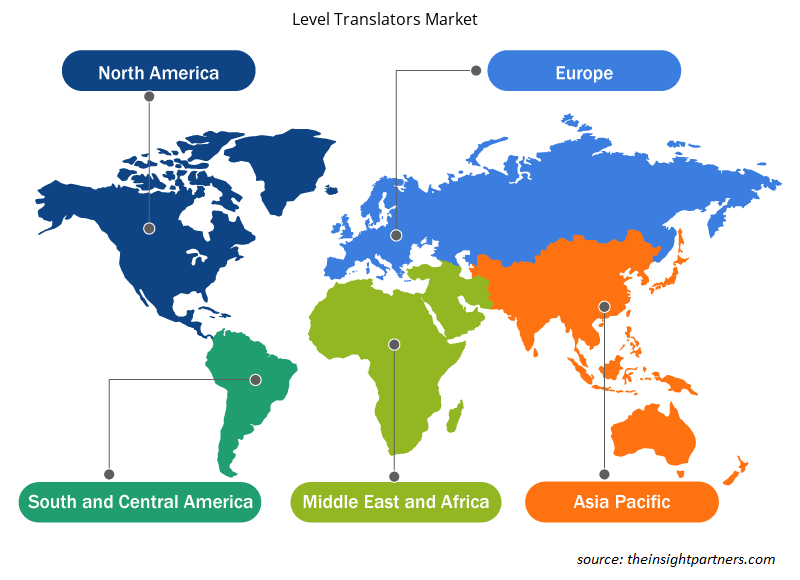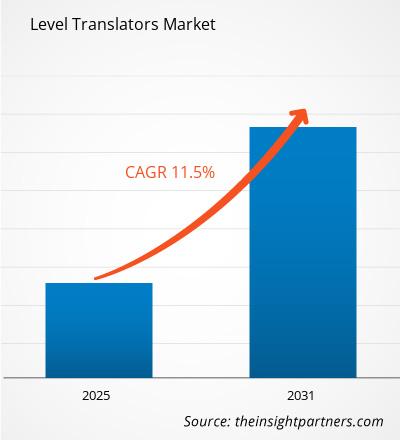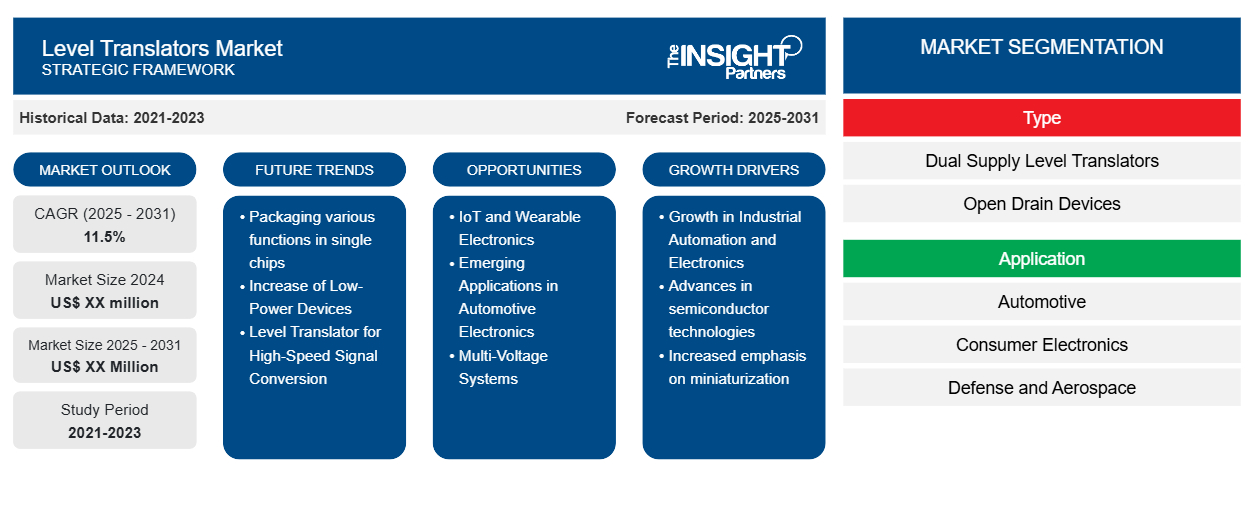Si prevede che il mercato dei traduttori di livello registrerà un CAGR dell'11,5% dal 2023 al 2031, con una dimensione di mercato in espansione da XX milioni di dollari nel 2023 a XX milioni di dollari entro il 2031.
Il Level Translators Market Report è suddiviso per tipo nei seguenti sottosegmenti: Dual Supply Level Translators e Open Drain Devices. È inoltre suddiviso per applicazione, tra cui Automotive, Consumer Electronics, Defense and Aerospace, Healthcare e altri. L'analisi globale è suddivisa a livello regionale e per i principali paesi. La valutazione del mercato è presentata in dollari USA per l'analisi segmentale di cui sopra, con proiezioni fino al 2031.
Scopo del rapporto
Il report Level Translators Market di The Insight Partners mira a descrivere il panorama attuale e la crescita futura, i principali fattori trainanti, le sfide e le opportunità. Ciò fornirà spunti a vari stakeholder aziendali, come:
- Fornitori/produttori di tecnologia: per comprendere le dinamiche di mercato in evoluzione e conoscere le potenziali opportunità di crescita, consentendo loro di prendere decisioni strategiche informate.
- Investitori: condurre un'analisi completa delle tendenze in merito al tasso di crescita del mercato, alle proiezioni finanziarie del mercato e alle opportunità esistenti lungo la catena del valore.
- Enti di regolamentazione: regolamentano le politiche e le attività di controllo sul mercato allo scopo di ridurre al minimo gli abusi, preservare la fiducia degli investitori e sostenere l'integrità e la stabilità del mercato.
Segmentazione del mercato dei traduttori di livello
Tipo
- Trasduttori a doppio livello di fornitura
- Dispositivi di scarico aperti
Applicazione
- Automobilistico
- Elettronica di consumo
- Difesa e aerospazio
- Assistenza sanitaria
- Altri
Personalizza questo report in base alle tue esigenze
Riceverai la personalizzazione gratuita di qualsiasi report, comprese parti di questo report, o analisi a livello nazionale, pacchetto dati Excel, oltre a usufruire di grandi offerte e sconti per start-up e università
- Scopri le principali tendenze di mercato in questo rapporto.Questo campione GRATUITO includerà analisi di dati che spaziano dalle tendenze di mercato alle stime e alle previsioni.
Driver di crescita del mercato dei traduttori di livello
- Crescita nell'automazione industriale e nell'elettronica: la domanda di sistemi automatizzati da parte dei produttori nei settori della produzione, dell'energia, dell'automotive e delle telecomunicazioni sta spingendo i traslatori di livello sul mercato a causa della loro esigenza di compatibilità dei dispositivi che funzionano con due diversi livelli di tensione.
- Progressi nelle tecnologie dei semiconduttori: la maggior parte dei dispositivi sviluppati sono realizzati per richiedere la traduzione di livello in modo che l'integrità del segnale non venga compromessa e anche per prevenire disallineamenti di tensione nei circuiti integrati. L'aumento dell'uso di componenti a bassa tensione nell'elettronica moderna si aggiunge a questa richiesta.
- Maggiore attenzione alla miniaturizzazione: poiché si lavora alla miniaturizzazione di dispositivi elettronici come dispositivi indossabili, smartphone e IoT, cresce la domanda di trasduttori di livello compatti ed efficienti, in grado di funzionare entro la potenza e lo spazio di piccoli dispositivi.wearables, smartphones, and IoT, the demand for compact efficient level translators capable of working within the power and space of small devices is growing.
Tendenze future del mercato dei traduttori di livello
- Confezionamento di varie funzioni in singoli chip: una tendenza osservata nel mercato dei traduttori di livello è l'integrazione di diverse funzioni, come regolazione della tensione, protezione e traduzione di livello, in un singolo chip. Questo consolidamento delle funzioni consente la riduzione delle dimensioni e della complessità dei sistemi elettronici, migliorandone al contempo le prestazioni e abbassandone i costi.
- Aumento di dispositivi a bassa potenza: i dispositivi elettronici a bassa potenza sono sempre più utilizzati, in particolare nei mercati dell'Internet delle cose e dei dispositivi indossabili. Ciò crea una domanda di traduttori efficienti e a bassissimo consumo; pertanto, tali dispositivi devono sostenere una comunicazione efficiente dal punto di vista energetico tra i componenti a bassa tensione.wearables markets. This creates a demand for efficient and highly low-power translators; hence, such devices have to sustain power-efficient communication among the low-voltage components.
- Convertitore di livello per conversione di segnali ad alta velocità: i convertitori di livello sono progettati per la conversione di segnali ad alta velocità con una perdita minima di prestazioni in applicazioni quali telecomunicazioni, elaborazione ad alta velocità, ecc. Ciò sarà di fondamentale importanza nei sistemi di trasferimento dati ultraveloci.
Opportunità di mercato per i traduttori di livello
- IoT ed elettronica indossabile: con l'espansione dei mercati IoT e wearable, i traduttori di livello saranno essenziali per gestire i diversi livelli di tensione tra i dispositivi connessi. Offrire un traduttore di livello specializzato, ottimizzato per applicazioni IoT e wearable, potrebbe aprire nuove e significative opportunità di crescita. and Wearable Electronics: As the IoT and wearables markets expand, level translators will be essential for managing the different voltage levels between connected devices. Offering a specialized level translator that is optimized for IoT and wearable applications may open up significant new growth opportunities.
- Applicazioni emergenti nell'elettronica automobilistica: la complessità dell'elettronica automobilistica è in continuo aumento, soprattutto con veicoli elettrici e sistemi di guida autonomi. I traduttori di livello possono facilmente fungere da ponte per una comunicazione corretta tra diversi livelli di tensione nei diversi sistemi delle auto a questo proposito.
- Sistemi multitensione: un'opportunità per sviluppare traslatori di livello I sistemi multitensione che consentono ai dispositivi di funzionare in modo efficiente con diverse fonti di alimentazione e sistemi elettronici, dai macchinari industriali all'elettronica di consumo, offrono l'opportunità di sviluppare traslatori di livello.
Approfondimenti regionali sul mercato dei traduttori di livello
Le tendenze regionali e i fattori che influenzano il mercato dei traduttori di livello durante il periodo di previsione sono stati ampiamente spiegati dagli analisti di Insight Partners. Questa sezione discute anche i segmenti e la geografia del mercato dei traduttori di livello in Nord America, Europa, Asia Pacifico, Medio Oriente e Africa e Sud e Centro America.

- Ottieni i dati specifici regionali per il mercato dei traduttori di livello
Ambito del rapporto di mercato sui traduttori di livello
| Attributo del report | Dettagli |
|---|---|
| Dimensioni del mercato nel 2023 | XX milioni di dollari USA |
| Dimensioni del mercato entro il 2031 | XX milioni di dollari USA |
| CAGR globale (2023-2031) | 11,5% |
| Dati storici | 2021-2022 |
| Periodo di previsione | 2024-2031 |
| Segmenti coperti | Per tipo
|
| Regioni e Paesi coperti | America del Nord
|
| Leader di mercato e profili aziendali chiave |
|
Traduttori di livello Attori del mercato Densità: comprendere il suo impatto sulle dinamiche aziendali
Il mercato dei traduttori di livello sta crescendo rapidamente, spinto dalla crescente domanda degli utenti finali dovuta a fattori quali l'evoluzione delle preferenze dei consumatori, i progressi tecnologici e una maggiore consapevolezza dei vantaggi del prodotto. Con l'aumento della domanda, le aziende stanno ampliando le loro offerte, innovando per soddisfare le esigenze dei consumatori e capitalizzando sulle tendenze emergenti, il che alimenta ulteriormente la crescita del mercato.
La densità degli operatori di mercato si riferisce alla distribuzione di aziende o società che operano in un particolare mercato o settore. Indica quanti concorrenti (operatori di mercato) sono presenti in un dato spazio di mercato in relazione alle sue dimensioni o al valore di mercato totale.
Le principali aziende che operano nel mercato dei traduttori di livello sono:
- Società per azioni Texas Instruments
- Tecnologie Infineon
- Semiconduttori NXP
- Dispositivi analogici
- STMicroelettronica
Disclaimer : le aziende elencate sopra non sono classificate secondo un ordine particolare.

- Ottieni la panoramica dei principali attori del mercato dei traduttori di livello
Punti chiave di vendita
- Copertura completa: il rapporto copre in modo completo l'analisi di prodotti, servizi, tipologie e utenti finali del mercato dei traduttori di livello, fornendo una panoramica olistica.
- Analisi degli esperti: il rapporto è compilato sulla base della conoscenza approfondita di esperti e analisti del settore.
- Informazioni aggiornate: il rapporto garantisce la pertinenza aziendale grazie alla copertura di informazioni recenti e tendenze nei dati.
- Opzioni di personalizzazione: questo report può essere personalizzato per soddisfare le esigenze specifiche del cliente e adattarsi in modo appropriato alle strategie aziendali.
Il rapporto di ricerca sul mercato dei traduttori di livello può, quindi, aiutare a guidare il percorso di decodifica e comprensione dello scenario del settore e delle prospettive di crescita. Sebbene possano esserci alcune preoccupazioni valide, i vantaggi complessivi di questo rapporto tendono a superare gli svantaggi.
- Analisi storica (2 anni), anno base, previsione (7 anni) con CAGR
- Analisi PEST e SWOT
- Valore/volume delle dimensioni del mercato - Globale, Regionale, Nazionale
- Industria e panorama competitivo
- Set di dati Excel
Report recenti
Testimonianze
Motivo dell'acquisto
- Processo decisionale informato
- Comprensione delle dinamiche di mercato
- Analisi competitiva
- Analisi dei clienti
- Previsioni di mercato
- Mitigazione del rischio
- Pianificazione strategica
- Giustificazione degli investimenti
- Identificazione dei mercati emergenti
- Miglioramento delle strategie di marketing
- Aumento dell'efficienza operativa
- Allineamento alle tendenze normative





















 Ottieni un campione gratuito per - Mercato dei traduttori di livello
Ottieni un campione gratuito per - Mercato dei traduttori di livello